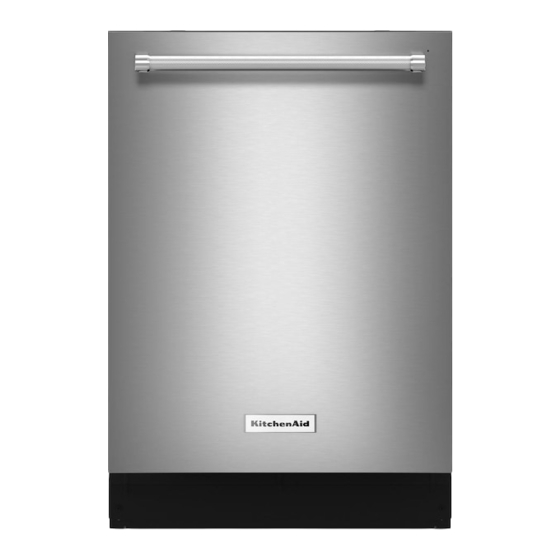KitchenAid KDTE234GPS1 Manual del usuario - Página 7
Navegue en línea o descargue pdf Manual del usuario para Lavavajillas KitchenAid KDTE234GPS1. KitchenAid KDTE234GPS1 17 páginas.
También para KitchenAid KDTE234GPS1: Instrucciones de uso (17 páginas)

First try the solutions suggested here. If you need further assistance or more recommendations that may help you to avoid a service call, refer to
the warranty page in this manual or visit producthelp.kitchenaid.com. In Canada, visit kitchenaid.ca. For internet connectivity questions, in the
U.S.A. or Canada, call 1-877-559-2603.
Contact us by mail with any questions or concerns at the address below:
In the U.S.A.:
KitchenAid Brand Home Appliances
Customer eXperience Center
553 Benson Road
Benton Harbor, MI 49022-2692
Please include a daytime phone number in your correspondence.
IF YOU EXPERIENCE
The Clean light
Check the following:
is flashing
■
■
■
■
Dishes do not
NOTE: Plastic and items with nonstick surfaces are difficult to dry because they have a porous surface which
dry completely
tends to collect water droplets. Towel drying may be necessary.
Use of rinse aid along with the Heat Dry or ProDry™ option is needed for proper drying.
Proper loading of items can affect drying.
■
Glasses and cups with concave bottoms hold water. This water may spill onto other items when you are
unloading the dishwasher.
■
Spotting/Filming
NOTES:
■
■
Confirm that the cloudiness is removable by soaking the item in white vinegar for 5 minutes. If the cloudiness
disappears, it is due to hard water. Adjust the amount of detergent and rinse aid. See the "Dishwasher Care"
section. If it does not come clear, it is due to etching.
Be sure the incoming water temperature is set at 120°F (49°C).
Try using the Hi-Temp Wash or Sani Rinse option.
To remove spotting, see the "Dishwasher Care" section.
Dishwasher does not
Be sure the dishwasher is loaded correctly. Improper loading can greatly decrease the washing performance.
clean completely
See the "Operating Your Dishwasher" section.
Check filter to ensure it is properly installed. Ensure the water intake screen on the floor of the dishwasher is not
plugged with food or debris. Clean if required.
Select the proper cycle for the type of soils. The ProWash™ or Tough cycle can be used for tougher loads.
Be sure the incoming water temperature is at least 120°F (49°C).
Use the proper amount of fresh detergent. More detergent is needed for heavier-soiled loads and hard
water conditions.
Scrape food from dishes prior to loading (do not prerinse).
If foam or suds are detected by the dishwasher sensing system, the dishwasher may not operate properly
or may not fill with water.
Suds can come from:
■
■
■
TROUBLESHOOTING
Was the cycle interrupted? Touch START/RESUME and close the door within 4 seconds.
Is the overfill protection float able to move up and down freely? Press down to release.
Be sure the water supply is turned on to the dishwasher. (This is very important following the new installation
of your dishwasher.)
Check for suds in the dishwasher. For more information on suds, see "Dishwasher does not clean completely."
For improved results, place items on the more slanted side of the rack.
Unload the bottom rack first.
Liquid rinse aid is necessary for drying and to reduce spotting.
Use the correct amount of detergent. If using powder or liquid/gel products, use package instructions.
Using the incorrect type of detergent, such laundry detergent, hand soap, or dish detergent for hand
washing dishes.
Not replacing the rinse aid dispenser cap after filling (or refilling) the rinse aid dispenser.
Using an excessive amount of dishwasher detergent.
In Canada:
KitchenAid Brand Home Appliances
Customer eXperience Centre
200 - 6750 Century Ave.
Mississauga, Ontario L5N 0B7
RECOMMENDED SOLUTIONS
7
